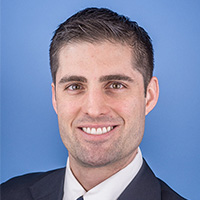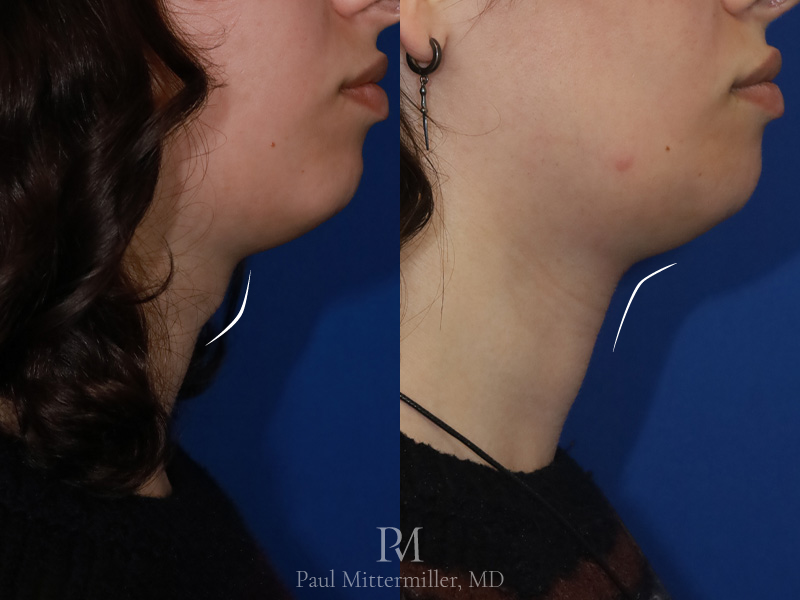
Tracheal Shave – Adam’s Apple Reduction Surgery
Tracheal shave surgery (aka Adam’s apple reduction, chondrolaryngoplasty, or thyroid cartilage reduction) is a procedure frequently performed during facial feminization surgery (FFS) that aims to feminize the neck by removing the cartilage prominence. This surgery can be performed for cisgender, transgender (MTF), and gender non-binary or non-conforming individuals.
This procedure is usually performed by surgeons with training in facial feminization surgery. This commonly includes plastic surgeons with fellowship training, facial plastic surgeons, and otolaryngologists with laryngology fellowship training. Dr. Mittermiller is one of only a few surgeons with specialty fellowship training in craniofacial surgery and facial feminization surgery.
- Tracheal Shave – Adam's Apple Reduction Surgery
- Introduction
- Surgery
- Preparation
- Recovery
- References
Introduction
What is tracheal shave surgery in FFS?
Tracheal shave surgery (aka Adam’s apple reduction) is typically performed as part of facial feminization surgery (FFS). Men typically have a more prominent thyroid cartilage than women, resulting in a prominence of the neck. A tracheal shave is performed to reduce this prominence and create a more feminine neck.
Why is a tracheal shave performed?
A chondrolaryngoplasty is performed for transgender women or non-binary individuals to enhance feminine appearance and relieve symptoms of gender dysphoria. The procedure reduces the masculine appearance of the neck by reducing the prominence and creating a smoother neck contour. Many patients find a thyroid cartilage reduction to be a dramatically gender affirming procedure.
Surgery
What are the tracheal shave techniques used in FFS?
The factor that is most commonly adjusted during tracheal shave surgery is the location of the incision.
Mid-neck incision
A mid-neck incision is one that is placed directly on the thyroid cartilage.1 Although this allows the surgeon to have the best access to the thyroid cartilage, it is also the most noticeable incision. This type of incision is not commonly performed due to the close proximity to the thyroid cartilage and the high degree of visibility.
Cervicomental incision
The cervicomental incision is placed higher on the neck within one of the creases where the neck meets the area under the chin. 2 This location leads to favorable scarring and is often difficult to identify or notice.
Submental incision
The submental incision is often placed directly underneath the chin.3 This area is well-hidden but often requires a longer scar than one placed closer to the thyroid cartilage. The longer scar is necessary to adequately visualize the thyroid cartilage during the reduction maneuvers.
Intraoral incision (Transoral tracheal shave)
An intraoral approach, or “scarless” tracheal shave, is usually only performed by a limited number of surgeons. 4, 5 This approach to thyroid cartilage reduction is through an incision in the lower lip. The scar is then located on the inside of the mouth.


Cartilage shave
There are also multiple techniques for how exactly the front surface of the thyroid cartilage is reduced. Although the main purpose is to decrease the prominence, some people use a variety of instruments include ultrasonic tools, scalpels, or electric burs. The ultrasonic tools include the Sonopet by Stryker and the Piezosurgery instruments by Mectron. Ultrasonic tools can be safer around the soft tissues in the neck, but the procedures duration can be increased with their use.


What are the risks of thyroid cartilage reduction?
The main concerning risk associated with a tracheal shave is the possibility of injuring the attachment of the vocal cords. If the attachment is injured, it can cause hoarseness or lowering of the voice. The effect can sometimes be only temporary, but for permanent conditions, it may require additional surgery in an attempt to correct the problem.
There are other potential complications from tracheal shave surgery that can also occur with any other surgery. These include risks of bleeding, infection, scarring, and injury to surrounding structures.
People often have swelling in the neck following a thyroid cartilage reduction. This can take a few months to subside to reveal the final result.
What type of anesthesia is used?
Tracheal shave is usually performed under general anesthesia. This allows for the airway to be protected during the operation and the procedure itself can be quite uncomfortable. It would be rare for any surgeon to offer an Adam’s apple reduction under local anesthesia only.
Can I combine a chondrolaryngoplasty with other feminizing facial procedures?
A tracheal shave (chondrolaryngoplasty) is frequently performed with other procedures during facial feminization surgery. These procedures can include the following:
Brow bone reduction
Cheek augmentation
Rhinoplasty
Lip lift
Chin and jaw reduction

Dr. Mittermiller is a plastic surgeon with specialty training in craniofacial surgery and facial feminization surgery. He is primarily located in Los Angeles, California and serves the broader Southern California area.
Contact us today to schedule a consultation.
Preparation
Am I a good candidate?
Tracheal shave surgery is offered for transgender (MTF) and gender nonbinary individuals who are seeking to feminize their neck. It can be the correct choice for people who are hoping to soften this masculine feature of the neck and enhance one’s pre-existing natural feminine features.
In some cases, patients may have a minimal cartilage prominence and in those cases, the benefits of surgery may not outweigh the risks.
Candidacy for surgery depends on multiple variables. One may not be an ideal candidate if they have medical problems that can result in significant complications from anesthesia.
Insurance companies frequently cover facial feminization for the treatment of gender dysphoria, which may occur when there is an incongruence between one’s physical traits and one’s gender identity.
How much does a thyroid cartilage reduction cost?
The cost of a thyroid cartilage reduction depends on multiple factors. The primary factor likely revolves around insurance coverage. When insurance covers an Adam’s apple reduction, the patient is responsible for covering the charges that are passed on to the patient. This varies from patient to patient depending on their individual insurance plan. The best way to determine the cost of surgery through insurance is to contact the office of your surgeon to discuss your insurance plan or to contact the insurance company directly.
When considering self pay for tracheal shave surgery there are additional factors affecting the cost. These include the items below:
Surgeon experience – More experienced surgeons generally charge higher rates than less experienced surgeons.
Hospital or surgery center – Undergoing the procedure at a hospital is usually more expensive than undergoing the procedure at a surgery center.
Anesthesia – Anesthesia costs depend on the experience of the anesthesia provider and duration of the operation.
How do I prepare for surgery?
There are many ways to prepare for a tracheal shave. A thorough set of instructions for preparing for FFS can be found here. In general, it is important to follow your doctor’s instructions and to ask any questions during the process.
Recovery
Are there scars after tracheal shave surgery?
The scars associated with tracheal shave surgery are related primarily to the location and size of the incisions. A list of the various incision locations is listed above. It is important to discuss with your surgeon the location and size of the incision they normally use. In addition to the location and size of the incision, the amount of tension or stress on the incision can affect how well or poorly the incision will heal. It is important to undergo the procedure with a surgeon who performs these types of surgeries routinely since they will normally perform the operation in the least traumatic way.
How is recovery? Is it painful?
An Adam’s apple reduction is usually not extremely painful. When performed as part of full-face FFS, it is usually one of the less painful sites. Your surgeon will prescribe medications to take after surgery to help reduce the pain you will experience. Oral medications are frequently sufficient to adequately manage postoperative pain. If the medications do not completely relieve your pain sufficiently, it is important to let your surgeon know immediately.
Recovery Progression
First week: During the first week after surgery, your voice may be affected. This can include a decrease in pitch or volume or ongoing hoarseness. This usually resolves within the first week, but it can sometimes take a few weeks to improve. The incision site is visible during this first week. Dr. Mittermiller uses dissolving stitches that are hidden underneath the skin, but there is a bandage that his placed on top of the incision.
One week to one month: During the first month after surgery, one should try to limit their strenuous activities to prevent unexpected bleeding and pain. The incision will continue to evolve during this initial phase. There will be less scabbing at the surgical site and the wound will gradually close completely and turn into a scar.
After the first month: After the first month following surgery, one can usually start to increase activities that are comfortable. It is important to discuss any specifics with your surgeon to prevent any problems with the healing process. The tracheal shave scar will acontinue to mature after the first month and sometimes can take 6-12 months to reach its permanent appearance.
Are there any dietary restrictions?
Dr. Mittermiller usually does not implement any dietary restrictions following a tracheal shave. Patients should be able to eat the same types of foods they were eating prior to the procedure.
Are the results permanent?
The visible results from a tracheal shave are permanent since the cartilage does not grow back following the procedure.
Is it possible to have a revision tracheal shave?
Revision tracheal shaves (Adam’s apple reductions) are uncommon, but they are possible in the correct scenario. Tracheal shave revision usually involve improving the appearance of a scar or removing additional cartilage. The neck scars can sometimes be noticeable after a tracheal shave and revision procedures can assist with improving their appearance.
Tracheal shave scar revisions: Injections of steroids or other medications can be used in specific scenarios to improve the appearance. In other situations, a surgical revision of the scar provides the best chance at improving the final appearance.
Additional thyroid cartilage reduction: Further reduction of the thyroid cartilage (revision tracheal shave) can be performed in specific patients if an insufficient amount was removed during the first procedure. This is highly dependent on the individual circumstances and it is best to have a consultation with an experienced surgeon prior to undergoing this procedure.
Can I see before and after photos of a tracheal shave?
Dr. Mittermiller is continuing to update the before and after photos that are being shared publicly. In addition to the photographs shared publicly, he has photographs of postoperative patients that he can share privately during a consultation. The publicly-available photographs can be reviewed in the website gallery through the link below:
Facial Feminization Photo Gallery

Dr. Mittermiller is a plastic surgeon with specialty training in craniofacial surgery and facial feminization surgery. He is primarily located in Los Angeles, California and serves the broader Southern California area.
Contact us today to schedule a consultation.
References
- Wolfort FG, Dejerine ES, Ramos DJ, Parry RG (1990) Chondrolaryngoplasty for appearance. Plast Reconstr Surg 86 (3):464-469; discussion 470. https://pubmed.ncbi.nlm.nih.gov/2385664/
- Spiegel H, Rodriguez G (2008) Chondrolaryngoplasty under general anesthesia using a flexible fiberoptic laryngoscope and laryngeal mask airway. Arch Otolaryngol Head Neck Surg 134 (7):704-708. doi:10.1001/archotol.134.7.704 https://pubmed.ncbi.nlm.nih.gov/18645118/
- Ihnat JM, Hu KG, Almeida MN, Parikh N, Hauc SC, Alper DP, Alperovich M (2024) Finesse in Chondrolaryngoplasty. Plast Reconstr Surg Glob Open 12 (1):e5539. doi:10.1097/GOX.0000000000005539 https://pubmed.ncbi.nlm.nih.gov/38260761/
- Eggerstedt M, Lee JC, Mendelsohn AH (2022) Transoral Feminizing Chondrolaryngoplasty: Development and Deployment of a Novel Approach in 77 Patients. Facial Plast Surg Aesthet Med. doi:10.1089/fpsam.2022.0016 https://pubmed.ncbi.nlm.nih.gov/35704281/
- Deng IY, Nguyen NH, Argame AA, James Lee, Michael Chu (2025) Comparison of Transoral and Transcutaneous Approaches for Gender-Affirming Thyroid Cartilage Reduction: A Case Series of 246 Patients. Plastic and Reconstructive Surgery 156 (2):319–327. doi:10.1097/PRS.0000000000011961 https://www.ncbi.nlm.nih.gov/pubmed/39903936






